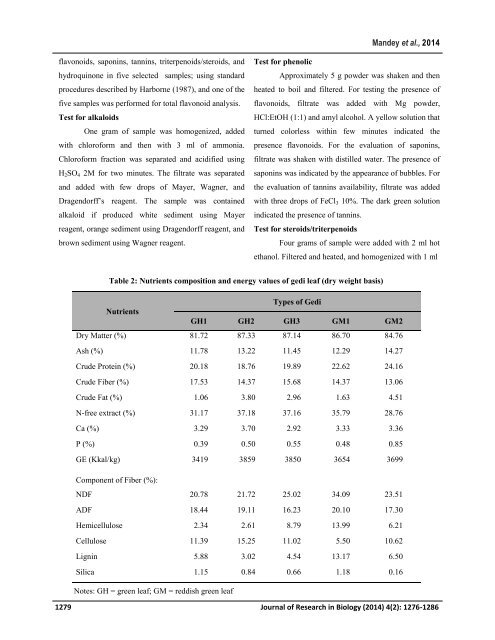Genetics characterization, nutritional and phytochemicals potential of gedi leaves (Abelmoschus manihot (L.) Medik) growing in the North Sulawesi of Indonesia as a candidate of poultry feed
Gedi, local name of Abelmoschus manihot (L.) Medik was used by local people in Northern Sulawesi-Indonesia as vegetable, because of its medicinal properties. The potency of gedi leaves in broiler diet has not been reported in literatures. The objective of this research was to investigate a genetic diversity of gedi commonly consumed as a gourmet cuisine in the North Sulawesi of Indonesia, and exploring the potential of this plant as a herb plant for a candidate of poultry feedstuff. Eight morphologically different gedi leaves (GH1, GH2, GH3, GH4, GH5, GH6, GM1 and GM2) that grow in Manado area, North Sulawesi of Indonesia were collected and identified. The leaves were extracted for DNA isolation followed by PCR and DNA sequencing analysis. During DNA isolation, 3 of 6 GH (GH4, GH5, GH6) were discontinued because of difficulty in separating the mucilage properties. Following PCR analysis, GH2 and GH3 did not produce bands and consequently were excluded from further analysis. In addition to that, chemical analysis was also performed to determine the phytochemical and nutritional contents .The results indicated that all gedi leaf samples showed similarity (99%) to species member of Abelmoschus manihot, and tribe of Malvaceae. In terms of proximate analysis, gedi leaves showed high crude protein (18.76 - 24.16%) and calcium (2.92-3.70%) content. Also, showed high crude fibre (13.06-17.53%). Together with the presence of alkaloid and steroidal saponin gedi leaves may offer beneficial effects as poultry feedstuff to a special production trait such as cholesterol-less meat.
Gedi, local name of Abelmoschus manihot (L.) Medik was used by local people in Northern Sulawesi-Indonesia as vegetable, because of its medicinal properties. The potency of gedi leaves in broiler diet has not been reported in literatures. The objective of this research was to investigate a genetic diversity of gedi commonly consumed as a gourmet cuisine in the North Sulawesi of Indonesia, and exploring the potential of this plant as a herb plant for a candidate of poultry feedstuff. Eight morphologically different gedi leaves (GH1, GH2, GH3, GH4, GH5, GH6, GM1 and GM2) that grow in Manado area, North Sulawesi of Indonesia were collected and identified. The leaves were extracted for DNA isolation followed by PCR and DNA sequencing analysis. During DNA isolation, 3 of 6 GH (GH4, GH5, GH6) were discontinued because of difficulty in separating the mucilage properties. Following PCR analysis, GH2 and GH3 did not produce bands and consequently were excluded from further analysis. In addition to that, chemical analysis was also performed to determine the phytochemical and nutritional contents .The results indicated that all gedi leaf samples showed similarity (99%) to species member of Abelmoschus manihot, and tribe of Malvaceae. In terms of proximate analysis, gedi leaves showed high crude protein (18.76 - 24.16%) and calcium (2.92-3.70%) content. Also, showed high crude fibre (13.06-17.53%). Together with the presence of alkaloid and steroidal saponin gedi leaves may offer beneficial effects as poultry feedstuff to a special production trait such as cholesterol-less meat.
Create successful ePaper yourself
Turn your PDF publications into a flip-book with our unique Google optimized e-Paper software.
M<strong>and</strong>ey et al., 2014<br />
flavonoids, sapon<strong>in</strong>s, tann<strong>in</strong>s, triterpenoids/steroids, <strong>and</strong><br />
hydroqu<strong>in</strong>one <strong>in</strong> five selected samples; us<strong>in</strong>g st<strong>and</strong>ard<br />
procedures described by Harborne (1987), <strong>and</strong> one <strong>of</strong> <strong>the</strong><br />
five samples w<strong>as</strong> performed for total flavonoid analysis.<br />
Test for alkaloids<br />
One gram <strong>of</strong> sample w<strong>as</strong> homogenized, added<br />
with chlor<strong>of</strong>orm <strong>and</strong> <strong>the</strong>n with 3 ml <strong>of</strong> ammonia.<br />
Chlor<strong>of</strong>orm fraction w<strong>as</strong> separated <strong>and</strong> acidified us<strong>in</strong>g<br />
H 2 SO 4 2M for two m<strong>in</strong>utes. The filtrate w<strong>as</strong> separated<br />
<strong>and</strong> added with few drops <strong>of</strong> Mayer, Wagner, <strong>and</strong><br />
Dragendorff’s reagent. The sample w<strong>as</strong> conta<strong>in</strong>ed<br />
alkaloid if produced white sediment us<strong>in</strong>g Mayer<br />
reagent, orange sediment us<strong>in</strong>g Dragendorff reagent, <strong>and</strong><br />
brown sediment us<strong>in</strong>g Wagner reagent.<br />
Test for phenolic<br />
Approximately 5 g powder w<strong>as</strong> shaken <strong>and</strong> <strong>the</strong>n<br />
heated to boil <strong>and</strong> filtered. For test<strong>in</strong>g <strong>the</strong> presence <strong>of</strong><br />
flavonoids, filtrate w<strong>as</strong> added with Mg powder,<br />
HCl:EtOH (1:1) <strong>and</strong> amyl alcohol. A yellow solution that<br />
turned colorless with<strong>in</strong> few m<strong>in</strong>utes <strong>in</strong>dicated <strong>the</strong><br />
presence flavonoids. For <strong>the</strong> evaluation <strong>of</strong> sapon<strong>in</strong>s,<br />
filtrate w<strong>as</strong> shaken with distilled water. The presence <strong>of</strong><br />
sapon<strong>in</strong>s w<strong>as</strong> <strong>in</strong>dicated by <strong>the</strong> appearance <strong>of</strong> bubbles. For<br />
<strong>the</strong> evaluation <strong>of</strong> tann<strong>in</strong>s availability, filtrate w<strong>as</strong> added<br />
with three drops <strong>of</strong> FeCl 3 10%. The dark green solution<br />
<strong>in</strong>dicated <strong>the</strong> presence <strong>of</strong> tann<strong>in</strong>s.<br />
Test for steroids/triterpenoids<br />
Four grams <strong>of</strong> sample were added with 2 ml hot<br />
ethanol. Filtered <strong>and</strong> heated, <strong>and</strong> homogenized with 1 ml<br />
Table 2: Nutrients composition <strong>and</strong> energy values <strong>of</strong> <strong>gedi</strong> leaf (dry weight b<strong>as</strong>is)<br />
Types <strong>of</strong> Gedi<br />
Nutrients<br />
GH1 GH2 GH3 GM1 GM2<br />
Dry Matter (%) 81.72 87.33 87.14 86.70 84.76<br />
Ash (%) 11.78 13.22 11.45 12.29 14.27<br />
Crude Prote<strong>in</strong> (%) 20.18 18.76 19.89 22.62 24.16<br />
Crude Fiber (%) 17.53 14.37 15.68 14.37 13.06<br />
Crude Fat (%) 1.06 3.80 2.96 1.63 4.51<br />
N-free extract (%) 31.17 37.18 37.16 35.79 28.76<br />
Ca (%) 3.29 3.70 2.92 3.33 3.36<br />
P (%) 0.39 0.50 0.55 0.48 0.85<br />
GE (Kkal/kg) 3419 3859 3850 3654 3699<br />
Component <strong>of</strong> Fiber (%):<br />
NDF 20.78 21.72 25.02 34.09 23.51<br />
ADF 18.44 19.11 16.23 20.10 17.30<br />
Hemicellulose 2.34 2.61 8.79 13.99 6.21<br />
Cellulose 11.39 15.25 11.02 5.50 10.62<br />
Lign<strong>in</strong> 5.88 3.02 4.54 13.17 6.50<br />
Silica 1.15 0.84 0.66 1.18 0.16<br />
Notes: GH = green leaf; GM = reddish green leaf<br />
1279 Journal <strong>of</strong> Research <strong>in</strong> Biology (2014) 4(2): 1276-1286

















